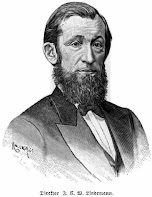The precious religious liberty which is now enjoyed by all the citizens of our dear Republic was not at all times present in America. A hundred years ago, and in some states probably even more recently, there were recognized and tolerated, ruling and suppressed church fellowships. In matters of faith, a tyranny was practiced at that time that seems hardly believable to us today, and that is all the more incomprehensible because it was practiced by people who, for the most part, had themselves fled Europe in order to escape the persecution of ruling state churches or fanatical princes. The history of that time is very instructive in several respects. We would like to share individual traits from it here, so that we can recognize all the more thoroughly and vividly what a blessing our God has bestowed upon us by allowing complete religious freedom to arise in this country, which has been blessed in so many ways, and by preserving it until now.
We have here to do only with the older colonies; for in the States which arose after 1788, free religious worship was guaranteed from the beginning. Before that time, however, one church party sought to rule over the other, either because the majority of the colonists belonged to it, or because it had existed first, or because the rich and powerful favored it. Let us see then also here by individual examples, how it happened at that time, according to vouched reports *).
_____________
*) The following works have been used in this work:
1. Magnalia Christi Americana: or, the Ecclesiastical History of New England, by Cotton Mather, 1702. 2nd Edit. Hartford, 1820.
2. History of the United States, by E. Willard. New York, 1852.
3. History of North America, by James Grahame, 1827.
4. Religion in America, by Robert Baird. New York, 1856.
In Virginia, the oldest colony (since 1585), from the beginning until the time of the Declaration of Independence, the Episcopal Church was the only one recognized by the government. No other religious party was to be tolerated; Presbyterians, Baptists, etc., were punished if discovered. The Presbyterians were the first to stand up against this tyranny, and to demand from the Legislature freedom of worship. In a memorandum submitted to the legislature († Reprinted in Robert Baird, pp. 216-218) they stated very clearly what the task of the state was and what the purpose of the church was. They did not ask for special privileges only for themselves, but they wanted all citizens to have equal rights in the practice of religion.



No comments:
Post a Comment
Comments only accepted when directly related to the post.